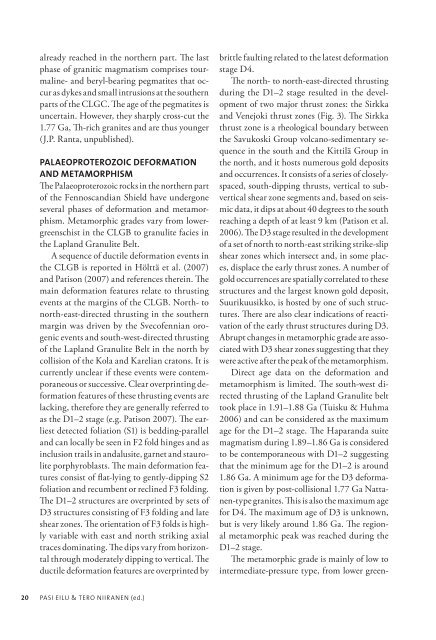Gold deposits in northern Finland - Arkisto.gsf.fi
Gold deposits in northern Finland - Arkisto.gsf.fi
Gold deposits in northern Finland - Arkisto.gsf.fi
Create successful ePaper yourself
Turn your PDF publications into a flip-book with our unique Google optimized e-Paper software.
already reached <strong>in</strong> the <strong>northern</strong> part. The last<br />
phase of granitic magmatism comprises tourmal<strong>in</strong>e-<br />
and beryl-bear<strong>in</strong>g pegmatites that occur<br />
as dykes and small <strong>in</strong>trusions at the southern<br />
parts of the CLGC. The age of the pegmatites is<br />
uncerta<strong>in</strong>. However, they sharply cross-cut the<br />
1.77 Ga, Th-rich granites and are thus younger<br />
(J.P. Ranta, unpublished).<br />
Palaeoproterozoic deformation<br />
and metamorphism<br />
The Palaeoproterozoic rocks <strong>in</strong> the <strong>northern</strong> part<br />
of the Fennoscandian Shield have undergone<br />
several phases of deformation and metamorphism.<br />
Metamorphic grades vary from lowergreenschist<br />
<strong>in</strong> the CLGB to granulite facies <strong>in</strong><br />
the Lapland Granulite Belt.<br />
A sequence of ductile deformation events <strong>in</strong><br />
the CLGB is reported <strong>in</strong> Hölttä et al. (2007)<br />
and Patison (2007) and references there<strong>in</strong>. The<br />
ma<strong>in</strong> deformation features relate to thrust<strong>in</strong>g<br />
events at the marg<strong>in</strong>s of the CLGB. North- to<br />
north-east-directed thrust<strong>in</strong>g <strong>in</strong> the southern<br />
marg<strong>in</strong> was driven by the Svecofennian orogenic<br />
events and south-west-directed thrust<strong>in</strong>g<br />
of the Lapland Granulite Belt <strong>in</strong> the north by<br />
collision of the Kola and Karelian cratons. It is<br />
currently unclear if these events were contemporaneous<br />
or successive. Clear overpr<strong>in</strong>t<strong>in</strong>g deformation<br />
features of these thrust<strong>in</strong>g events are<br />
lack<strong>in</strong>g, therefore they are generally referred to<br />
as the D1–2 stage (e.g. Patison 2007). The earliest<br />
detected foliation (S1) is bedd<strong>in</strong>g-parallel<br />
and can locally be seen <strong>in</strong> F2 fold h<strong>in</strong>ges and as<br />
<strong>in</strong>clusion trails <strong>in</strong> andalusite, garnet and staurolite<br />
porphyroblasts. The ma<strong>in</strong> deformation features<br />
consist of flat-ly<strong>in</strong>g to gently-dipp<strong>in</strong>g S2<br />
foliation and recumbent or recl<strong>in</strong>ed F3 fold<strong>in</strong>g.<br />
The D1–2 structures are overpr<strong>in</strong>ted by sets of<br />
D3 structures consist<strong>in</strong>g of F3 fold<strong>in</strong>g and late<br />
shear zones. The orientation of F3 folds is highly<br />
variable with east and north strik<strong>in</strong>g axial<br />
traces dom<strong>in</strong>at<strong>in</strong>g. The dips vary from horizontal<br />
through moderately dipp<strong>in</strong>g to vertical. The<br />
ductile deformation features are overpr<strong>in</strong>ted by<br />
brittle fault<strong>in</strong>g related to the latest deformation<br />
stage D4.<br />
The north- to north-east-directed thrust<strong>in</strong>g<br />
dur<strong>in</strong>g the D1–2 stage resulted <strong>in</strong> the development<br />
of two major thrust zones: the Sirkka<br />
and Venejoki thrust zones (Fig. 3). The Sirkka<br />
thrust zone is a rheological boundary between<br />
the Savu koski Group volcano-sedimentary sequence<br />
<strong>in</strong> the south and the Kittilä Group <strong>in</strong><br />
the north, and it hosts numerous gold <strong>deposits</strong><br />
and occurrences. It consists of a series of closelyspaced,<br />
south-dipp<strong>in</strong>g thrusts, vertical to subvertical<br />
shear zone segments and, based on seismic<br />
data, it dips at about 40 degrees to the south<br />
reach<strong>in</strong>g a depth of at least 9 km (Patison et al.<br />
2006). The D3 stage resulted <strong>in</strong> the development<br />
of a set of north to north-east strik<strong>in</strong>g strike-slip<br />
shear zones which <strong>in</strong>tersect and, <strong>in</strong> some places,<br />
displace the early thrust zones. A number of<br />
gold occurrences are spatially correlated to these<br />
structures and the largest known gold deposit,<br />
Suurikuusikko, is hosted by one of such structures.<br />
There are also clear <strong>in</strong>dications of reactivation<br />
of the early thrust structures dur<strong>in</strong>g D3.<br />
Abrupt changes <strong>in</strong> metamorphic grade are associated<br />
with D3 shear zones suggest<strong>in</strong>g that they<br />
were active after the peak of the metamorphism.<br />
Direct age data on the deformation and<br />
metamorphism is limited. The south-west directed<br />
thrust<strong>in</strong>g of the Lapland Granulite belt<br />
took place <strong>in</strong> 1.91–1.88 Ga (Tuisku & Huhma<br />
2006) and can be considered as the maximum<br />
age for the D1–2 stage. The Haparanda suite<br />
magmatism dur<strong>in</strong>g 1.89–1.86 Ga is considered<br />
to be contemporaneous with D1–2 suggest<strong>in</strong>g<br />
that the m<strong>in</strong>imum age for the D1–2 is around<br />
1.86 Ga. A m<strong>in</strong>imum age for the D3 deformation<br />
is given by post-collisional 1.77 Ga Nattanen-type<br />
granites. This is also the maximum age<br />
for D4. The maximum age of D3 is unknown,<br />
but is very likely around 1.86 Ga. The regional<br />
metamorphic peak was reached dur<strong>in</strong>g the<br />
D1–2 stage.<br />
The metamorphic grade is ma<strong>in</strong>ly of low to<br />
<strong>in</strong>termediate-pressure type, from lower green<br />
20 Pasi Eilu & Tero Niiranen (ed.)
















